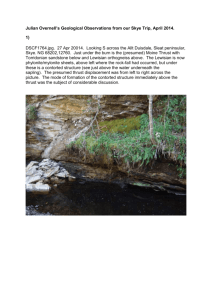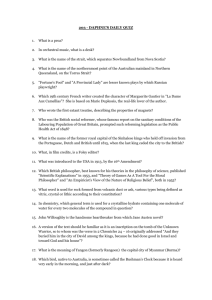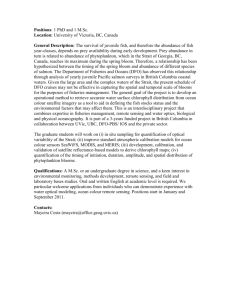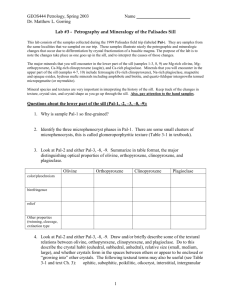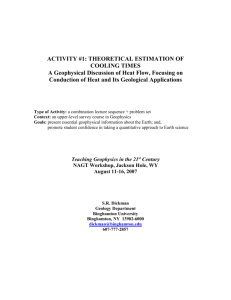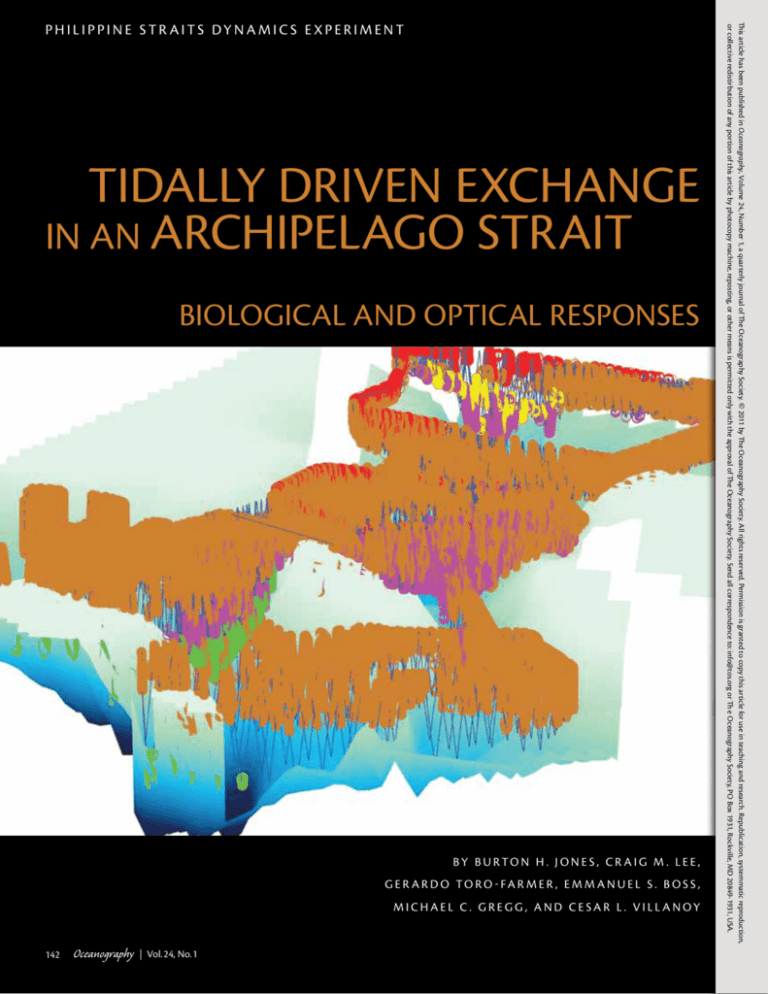
Tidally Driven Exchange
in an Archipelago Strait
Biological and Optical Responses
By Burton H . J one s , Cr aig M . Lee ,
G e r a r d o T o r o - F a r m e r , E m m a n u e l S . B o ss ,
M i c h a e l C . G r e g g , a nd C e s a r L . V i l l a n o y
| Vol.24, No.1
Oceanography
142
This article has been published in Oceanography, Volume 24, Number 1, a quarterly journal of The Oceanography Society. © 2011 by The Oceanography Society. All rights reserved. Permission is granted to copy this article for use in teaching and research. Republication, systemmatic reproduction,
or collective redistirbution of any portion of this article by photocopy machine, reposting, or other means is permitted only with the approval of The Oceanography Society. Send all correspondence to: info@tos.org or Th e Oceanography Society, PO Box 1931, Rockville, MD 20849-1931, USA.
P h i l i pp i n e S t r a i t s D y n a m i c s E x p e r i m e n t
Abstr ac t. Measurements in San Bernardino Strait, one of two major connections
between the Pacific Ocean and the interior waters of the Philippine Archipelago,
captured 2–3 m s-1 tidal currents that drove vertical mixing and net landward
transport. A TRIAXUS towed profiling vehicle equipped with physical and optical
sensors was used to repeatedly map subregions within the strait, employing survey
patterns designed to resolve tidal variability of physical and optical properties. Strong
flow over the sill between Luzon and Capul islands resulted in upward transport and
mixing of deeper high-salinity, low-oxygen, high-particle-and-nutrient-concentration
water into the upper water column, landward of the sill. During the high-velocity
ebb flow, topography influences the vertical distribution of water, but without the
diapycnal mixing observed during flood tide. The surveys captured a net landward
flux of water through the narrowest part of the strait. The tidally varying velocities
contribute to strong vertical transport and diapycnal mixing of the deeper water into
the upper layer, contributing to the observed higher phytoplankton biomass within
the interior of the strait.
Introduc tion
Strong archipelago throughflow, such
as that observed in the Philippines,
interacts with complex bathymetry
to produce a range of energetic flow
regimes. Orographic steering by island
topography can influence the wind
and thermal forcing of the region,
introducing small-scale lateral variations in the forcing fields (Pullen et al.,
2008). Subsurface topography, at least as
complex as the terrestrial topography,
includes many between-island straits and
sills with complex shapes. Historically,
the interior seas of the archipelago
have been relatively underexplored,
with few in situ, subsurface observations. Remotely sensed ocean color
provides some indication of the probable
distributions of phytoplankton and
particles as well as related properties in
the region (e.g., Figure 1). However, in
the absence of appropriate ground truth
measurements, the possible confounding
optical influences of the coastal region
(e.g., adjacency effects, bottom contributions) produce significant uncertainty
in ocean color products. In addition,
remotely sensed ocean color is limited
to the upper few meters of the water
column, limiting its utility for studying
the complex subsurface processes that
can affect optical variability.
This study examines flow dynamics
and the resulting distribution of biogeochemical and bio-optical parameters
in the San Bernardino Strait region
(Figure 1, white box) surveyed during
the 2009 PhilEx Intensive Observational
Period (IOP-09). To our knowledge, few
previous data exist from this region;
even the mean net transport is uncertain (Gordon et al., 2011). The earliest
modern observations were collected by
the US Coast and Geodetic Survey in
the 1920s (http://www.photolib.noaa.
gov/htmls/cgs00029.htm), but, to our
knowledge, no data from this effort
have been published. The Japanese fleet
passed through the strait on its way to
a surprise attack on the American fleet
during the World War II Battle of Leyte
Gulf, providing historical significance to
the region. Recently, the strait’s strong
tidal currents have made it an area of
interest for tidal power generation (Jones
and Rowley, 2002).
San Bernardino Strait is a relatively
narrow passage on the northeastern side
of the Philippine Archipelago. The strait
is about 6.5-km wide at its narrowest
point, between Luzon and Capul islands,
where sill depth is about 90 m at the
channel’s center (Figure 2). Current
speeds of up to nearly 4.5 m s-1 have
been reported near the southern tip of
Capul (Peña and Mariño, 2009), and,
one of the authors has observed current
speeds of roughly 4 m s-1 over the sill
during prior efforts in the area.
Straits and their associated sills have
been the subject of investigation for a
long period in modern oceanography.
Some of the earliest and most sustained
interest has been in the Strait of Gibraltar
Oceanography
| March 2011
143
et al., 2000; Sannino et al., 2002).
Various studies examined a range
of interactions of flow and topography
in other strait regions; for example,
complex three-dimensional flow structure has been observed in Knight Inlet,
BC, Canada (Klymak and Gregg, 2001;
Lamb, 2004). Ohlman (2011) examined
surface flow along the boundaries of San
Bernardino Strait simultaneous with
the results discussed here, observing
large vorticity and strain rates at subkilometer scales along the boundaries of
the strait. Although maximum velocities
Figure 1. Ocean color image of chlorophyll concentration for the Philippine Archipelago
between 7°N and 17°N. The image is a composite of MODIS Aqua sensor images for the
period of February 15–21, 2009. The area of focus for this paper, San Bernardino Strait, is
outlined in white on the right center of the image. Image courtesy of Sherwin Ladner and
Robert Arnone, NRL Stennis
(Stommel et al., 1973; Kinder and
Parrilla, 1987; Bryden et al., 1994; Gomez
et al., 2000; Tsimplis, 2000; Vargas
et al., 2006). Research on Gibraltar has
addressed a range of issues, including
aspiration of deeper water (Kinder
and Parrilla, 1987) and generation of
internal waves and tides (Longo et al.,
1992; Richez, 1994; Tsimplis, 2000;
Morozov et al., 2002) as well as changes
in Froude number and pressure with the
compressed flow over the sill (Lafuente
Burton H. Jones (bjones@usc.edu) is Professor (Research), Marine Environmental
Biology, University of Southern California, Los Angeles, CA, USA. Craig M. Lee is Principal
Oceanographer and Associate Professor, Applied Physics Laboratory, University of
Washington, Seattle, WA, USA. Gerardo Toro-Farmer is PhD Candidate, University of
Southern California, Los Angeles, CA, USA. Emmanuel S. Boss is Professor, University
of Maine, Orono, ME, USA. Michael C. Gregg is Professor, Applied Physics Laboratory,
University of Washington, Seattle, WA, USA. Cesar L. Villanoy is Professor, Marine Science
Institute, University of the Philippines Diliman, Quezon City, Philippines.
144
Oceanography
| Vol.24, No.1
vary widely between different straits,
those observed at San Bernardino
are large, with reported velocities
at other sites often less than 1 m s-1
(e.g., Klymak and Gregg, 2001; ValleLevinson et al., 2001; Vargas et al., 2006;
Gregg and Pratt, 2010).
Few of the many studies of flow
in straits and over sills throughout
the world have included significant
biological, optical, and/or chemical
measurements. In part, difficulties associated with sampling in regions of strong
flow have limited these observations. In
this paper, we present observations that
employ the integration of bio-optical and
biogeochemical sensors into a modern
tow vehicle to evaluate the variability
of physical, bio-optical, and chemical
signatures in the very dynamic San
Bernardino Strait.
Approach
The challenge presented in sampling
tidally dominated straits is to repeatedly occupy three-dimensional surveys
rapidly enough to resolve energetic
variability at tidal (in San Bernardino
Strait, predominately diurnal) frequencies. To accomplish this task, we used a
MacArtney TRIAXUS towed, undulating
vehicle to map the three-dimensional
distributions of physical, chemical, and
inherent optical properties. TRIAXUS
maintained a vertical speed of 1 m s-1
while typically being towed at 7 knots,
with along-track horizontal resolution
of 1 km or less, dependent on profile
depth. TRIAXUS carried two pairs of
Sea-Bird temperature and conductivity
sensors along with up (1200 kHz) - and
down (300 kHz)-looking RDI acoustic
Doppler current profilers. Optical
sensors included a WETLabs C-Star
transmissometer, WETStar chlorophyll
and CDOM fluorometers, WETLabs
Triplet optical backscatter sensor
(532, 660, and 880 nm), and a WETLabs
AC-S absorption/attenuation spectrophotometer. A Sea-Bird SBE43 dissolved
oxygen sensor on the vehicle measured
dissolved oxygen concentration. The
vehicle’s sensor and engineering data
were telemetered via a single-mode fiber,
and recorded and displayed in real-time
using the University of WashingtonApplied Physics Laboratory’s control and
acquisition software.
The AC-S data were processed using
the instrument’s standard water calibration procedures performed routinely
with deionized water that had been
filtered through a 0.2-µ filter and UV
irradiated to remove dissolved organic
carbon. Temperature and salinity corrections of the attenuation and absorption
data were performed according to
Sullivan et al. (2006). Scattering corrections were performed based on the third
method of Zaneveld et al. (1994).
In order to preserve the structure in
the optical data, the full data set was
processed onto a common time base of
0.25 seconds, the sampling interval of
the AC-S spectrophotometer, where all
times were recorded in universal time
(UT). Because the absorption at 720 nm
has strong temperature dependence, the
720 nm absorption was compared with
the conductivity-temperature-depth
(CTD) temperature data to establish
the time offset between the two sensors.
The AC-S data were then shifted in
time to minimize the offset between
the AC-S absorption at 720 nm and the
CTD temperature. Once this alignment
was accomplished, the other optical
sensors were temporally aligned with
the AC-S variables to ensure consistency of temporal and spatial alignment
of all of the data.
Four optical variables derived
from the absorption and attenuation measurements are used in the
observations presented. Chlorophyll
concentration was calculated from the
AC-S absorptions at 675 and 650 nm
using chlorophyll-specific absorption
of 0.014 m2 mg-1) (Davis et al., 1997;
Boss et al., 2007). Optical scattering, bλ
(where λ is wavelength in nm), is the
difference between total attenuation (cλ )
Figure 2. Topography and TRIAXUS survey tracks for the San Bernardino
Strait region during February 17–21, 2009. Topography was interpolated
from the ship’s echosounder. Each of the survey regions, except for the most
southern one, was repeatedly mapped for at least a 24-hour period. The
Pacific Ocean (seaward) is north and east of the region shown; landward
is toward the south and west. The San Bernardino sill is the shallow region
located between the islands of Luzon and Capul.
Oceanography
| March 2011
145
and absorption (aλ) (i.e., bλ = cλ – aλ).
Gamma (γ) is the spectral slope of cp(λ),
the attenuation due to the particulate
components in the water, fitted to a
hyperbolic function (Boss et al., 2001):
with the vehicle’s colored dissolved
organic matter (CDOM) fluorescence
from 4–6-m depth. The ag spectrum was
cp(λ) = cp(λ0) • (λ/λ0)-γ.
ag(λ) = ag(400) • e–Se (λ – λ400),
Typically, cp(λ) is calculated by
subtracting the dissolved attenuation,
cg(λ), from the total attenuation, ctot(λ),
where cg(λ) is essentially dissolved
absorption, ag(λ). Because TRIAXUS
did not carry a second AC-S where the
inflow was filtered to provide cg(λ), we
estimated dissolved absorption (ag) by
correlating the near-surface dissolved
absorption at 400 nm, measured with
an AC-S in line with the ship’s nearsurface flowthrough seawater system
that sampled from about 5-m depth,
then calculated using the equation from
Twardowski et al. (2004):
where se is the spectral slope for ag as
a function of wavelength (λ). For each
observation, ag(400) was estimated from
the measured CDOM fluorescence, and
for data from San Bernardino Strait,
the value of se that best fit the data
was 0.012. The cp spectrum was then
calculated by subtracting the estimated
ag spectrum from the measured total
attenuation spectrum.
TRIAXUS surveys were planned
such that multiple iterations of each
survey track could be performed within
2.0
~1.9 m
Tidal Height (m)
~0.5 m
1.0
0.5
0.0
02/08
02/15
Date 2009
02/22
03/01
Figure 3. Measured tidal height at Legaspi, Albay, Philippines, for February 2009. The location of the tidal station is indicated in the Figure 1 inset. The red portion of the tidal series
is the tidal height during the period that San Bernardino Strait was mapped for the effort
described in this paper.
146
Oceanography
| Vol.24, No.1
Observations
TRIAXUS surveys of San Bernardino
Strait spanned the five-day period
between February 17 and 21, 2009,
during the neap tide (Figure 3). Diurnal
variability that approximated the O1 tide
(period ~ 25.8 hours; not shown) dominated during the measurement period.
This timing turned out to be fortuitous
because during spring tides, current
velocities through the strait can reach
speeds of 4–4.5 m s-1, exceeding typical
TRIAXUS towing speeds.
T-S Distributions within the Strait
1.5
−0.5
02/01
a 24-hour span, thus resolving the
diurnal and, often, semidiurnal tidal
components within each survey pattern.
To meet this rapid-sampling criteria, we
planned four survey sites and a thalweg
section that, when considered together,
provided spatial coverage spanning
critical areas of the San Bernardino Strait
region (Figure 2).
The T-S properties for the region exhibit
two major components (Figure 4):
warm exterior Pacific water (above the
heavy black line in Figure 4, left panel),
and archipelago interior water (below
the heavy black line in Figure 4). The
warm Pacific water was characterized by
two major end points. Exterior surface
water salinity was less than 33.6 and
temperature was greater than 27.5°C.
Exterior deep water, in contrast, was
saltier (S > 34.4) and found at densities (σθ) more than 22.75 kg m-3. A
third end point, exterior intermediate
water, was similar in salinity to the
exterior deep water, but warmer and
therefore less dense. The Pacific end
points were vertically layered along
the outermost section. During the
period of observation (Figure 4, right
panel), Pacific surface water (identified
by red) entered the channel along the
northwestern boundary, but did not
penetrate into the interior side of the
sill between Luzon and Capul (Figure 4,
right panel). The intermediate water was
only found in the northernmost transect.
Pacific deep water penetrated across the
sill into the region south of the sill at
intermediate depths.
The interior water, below the heavy
black line in Figure 4, was comprised of
two primary components. It was characterized in the broadest sense by intermediate salinities between 34 and 34.47
and densities greater than 23 kg m-3.
For clarity in the graphics, a more
tightly constrained characterization is
used where densities are greater than
24 kg m-3 (Figure 4, left panel, outlined
in green). The interior deep water was
found below 100-m depth (Figure 4,
right panel), but it also extended seaward
(northeastward) of the sill during the
ebb phase of the tidal cycle (not visible in
Figure 4, right panel).
The interior surface water was
identified as upper-layer water where
chlorophyll concentrations were greater
than 1 mg m-3 at depths less than 20 m.
The brown box in Figure 4 (left panel)
outlines the T-S boundaries of this
shallow, high-chlorophyll water. The
region with these T-S properties, though
not necessarily high in chlorophyll,
extended from the inner strait into the
outer strait north of the sill, primarily
along the eastern half of the strait
(Figure 4, right panel).
Velocity Field
Figure 5 displays the three-dimensional
velocity fields during both ebb and flood
tides. During the ebb tide, velocities
were predominantly seaward through
the channel at all depths (Figure 5,
left panel). Some eastward surface flow
was observed north of Capul, but otherwise all flow was seaward with maximum
velocities exceeding 2.5 m s-1 seaward
of the sill north of Capul. In the outer
portions of the strait, the flow along the
boundaries both near Samar and in the
northwest corner near Luzon was relatively slow and the direction less clear
than nearer the center of the strait.
During the flood tide, although the
flow was slightly more complex, most
of the flow was landward into the strait
(Figure 5, right panel). The maximum
observed velocity was 2.3 m s-1 toward
the southwest (landward) above the
center of the sill. A weak cyclonic circulation was apparent on the west side of
the tidal jet along the southern coast of
Luzon. During the 24-hour period that
this region was surveyed, numerous
small eddies were visible in that area
Figure 4. Water-mass distribution within the San Bernardino Strait region for the period of February 17–21, 2009. The color-coded triangles and rectangles in the left panel identify the various temperature-salinity (T-S) end points. The heavy black line in the left panel separates the exterior Pacific
water above the line from the interior archipelago water below the line. The blue lines in the right panel show the vehicle path and locations for all
T-S points shown in the left panel. The colors in the right panel correspond to the end points identified in the left panel (polygon colors). The regions
where only blue is evident in the right panel indicate areas where the T-S values lay outside all of the end points identified in the left panel. Each survey
pattern shown (see Figure 2 represents multiple passes, spanning the tidal cycle, with the TRIAXUS and its instrumentation.
Oceanography
| March 2011
147
along the southern coast of Luzon. Below
about 140 m, in the deep basin landward
of the sill, velocities were seaward (NNE)
at speeds on the order of 0.1–0.2 m s-1.
Overall Distribution Patterns
Distributions of salinity, chlorophyll,
optical scattering at 532 nm (b532),
and dissolved oxygen display striking
contrasts between periods of ebb and
flood tides (Figure 6). During the ebb,
salinity of the seaward-moving waters
ranged from 33.8 to 34.4, fresher near
the surface with salinity increasing with
depth (Figure 6a). During ebb, interior
salinities were never as high or as low
as those observed in the Pacific waters
that entered the strait during flood
(Figure 6e). The highest chlorophyll
concentrations (2–3 mg m-3) occurred
within the strait’s interior, south of
Luzon, typically within the upper
50 m. The distribution of scattering
(b532), indicative of suspended particle
concentration, typically mirrored that
of chlorophyll, with the highest particle
concentrations within the strait’s interior. This tight relationship between
chlorophyll and backscatter did not hold
in all regions. For example, a region
of elevated particle concentrations but
low chlorophyll was observed in the
deep basin onshore of the sill (Figure 6b
and c). The ebb tide carried much of the
particulate matter, especially the phytoplankton, seaward into the outer portion
of the strait, north of the sill. Waters
with elevated chlorophyll concentrations can be seen in the northernmost
line of the outer survey, perhaps moving
along the eastern side of the strait.
Some of the deep water with elevated
particle concentrations was observed
rising over the sill during the ebbing
tide (Figure 6g).
The highest oxygen concentrations
observed (> 220 µmol kg-1) coincided
with the highest chlorophyll concentrations during ebb, and were observed at
the most interior portion of the strait
(Figure 6d). The lowest oxygen concentrations (< 70 µmol kg-1) were found
in the deeper basins landward of the
sill. The water carried seaward during
the ebb contained intermediate oxygen
concentrations, entraining water from
various depths in the interior during the
seaward transit. Intermediate oxygen
levels (< 190 µmol kg-1) in the most
seaward (northern) section indicate the
presence of strait interior waters, consistent with the observations of chlorophyll
and b532 . Similar to the distribution of
b532 , low oxygen concentrations were
observed rising over the sill during ebb.
Water-column properties changed
dramatically during the flood tide, as can
be seen by comparing property distributions during flood (Figure 6e–h) with
those from the ebb (Figure 6a–d). During
flood, the strait exhibited both high and
low extremes of salinity, with low salinities (< 33.5) near the surface and higher
salinities (> 34.5) in the deeper layers,
consistent with the T-S distribution
Figure 5. The three-dimensional velocity field through San Bernardino Strait during mid-ebb and mid-flood stages of the tidal cycle. The vectors
are vertically averaged into 50-m bins with color from red to blue for subsequent depth layers from the surface (0–50 m) to deepest (150–200 m).
The location of the San Bernardino sill is indicated in the left panel.
148
Oceanography
| Vol.24, No.1
Figure 6. Threedimensional
distributions of
salinity, chlorophyll,
optical scattering at
532 nm (b532), and
dissolved oxygen
during the middle
ebb (left panels)
and the late phase
flood for the entire
San Bernardino
Strait region. These
distributions are
composites created
by selecting survey
passes for the
same phase of the
tide from the four
separate surveys
(Figure 2 shows
the survey regions;
the most southern
survey region is not
included).
Oceanography
| March 2011
149
presented earlier (Figures 4 and 6a).
Pacific waters, depleted in chlorophyll and suspended particles,
penetrated across the sill and into the
region south of Luzon, where a sharp
frontal boundary separated them from
the high-chlorophyll interior waters.
Chlorophyll and b532 were highly correlated throughout most of the region,
indicating that the particle field was
phytoplankton-dominated. However,
landward of the sill and adjacent to the
island of Capul, low chlorophyll but
high b532 in the upper layer indicates
elevated concentration of particles other
than phytoplankton.
The flood tide produced a distinctive
patter in dissolved oxygen concentration. Oxygen concentrations in the
incoming Pacific water exceeded
190 µmol kg-1 throughout the water
column (Figure 6h). Oxygen concentrations landward of the sill exhibited
“
phytoplankton did not dominate the
upper-layer particle field), oxygen
concentrations less than 185 µmol kg-1
were observed in the upper 80 m.
Thalweg Distributions During
the Late Flood Tide
An examination of the area directly
over the sill provides insight into tidally
driven processes. During the ebb tide,
currents along the entire track were
seaward throughout the water column
(Figure 7a–d, black vectors). Isopycnal
surfaces tended to mirror bottom topography, rising over the sill and descending
again downcurrent, on the sill’s seaward
side (Figure 7a–d). In the upper layer,
relatively high chlorophyll concentrations (0.5 to >1 mg m-3), along with the
associated particles (b532 , Figure 7c),
were transported seaward across the sill.
High particle loads from the lower layer
were lifted over the sill but descended on
Strong archipelago throughflow, such
as that observed in the Philippines, interacts
with complex bathymetry to produce a range
of energetic flow regimes.
strong vertical structure, with concentrations above 205 µmol kg-1 observed in
the high-chlorophyll interior surface
water. In the basins landward of the
sill, oxygen concentration decreased
with increasing density to less than
70 µmol kg-1 in the deepest parts of
the basin. In the same region landward of the sill, west of Capul (where
150
Oceanography
| Vol.24, No.1
”
the seaward side, following the isopycnals and oxygen concentration. Gamma,
the spectral slope of the particulate
attenuation, shows a pattern similar to
that of the other variables, indicating
that particles found in the lower part of
the water column, landward of the sill,
were larger than particles in the upper
layer where σθ was less than 23 kg m-3.
Toward the end of the flood, velocities
were still landward in the upper layer,
but weakly seaward below sill depth on
the landward side of the sill. Over the
sill, currents were seaward in the lower
half of the water column (Figure 7e–h).
This thalweg was occupied near the end
of flood, and likely captured conditions
as the currents were reversing. As during
ebb, isopycnals rose as the flow passed
over the sill, but did not sink down
immediately on the lee (landward) side of
the sill. Chlorophyll concentration of the
incoming water was less than 0.5 mg m-3
along the entire section (Figure 7e).
However, b532 in the upper 75 m
increased from < ~ 0.13 m-1 seaward of
the sill to > 0.16 m-1 over and landward
from the sill (Figure 7g). Given the
observed distribution of b532 (Figure 7g),
the only apparent source of particulates
during the flood was the deep water on
the landward side of the sill.
Two additional variables, dissolved
oxygen and γ, both show distributions
similar to that of b532 during late flood.
Upper-layer dissolved oxygen and γ
were lower in the region where b532 was
elevated. Like b532 , the only apparent
source for low oxygen and low γ was
the deep water landward of the sill.
The optical index of refraction (ηp, not
shown in the figure) exhibited the same
pattern where higher values of ηp in the
upper layer landward of the sill reflect
the higher values below 125 m on the
landward side of the sill (consistent with
dominance by inorganic particles).
Discussion
Vertical Flux
The patterns observed in San Bernardino
Strait during the late flood tide suggest a
significant vertical flux on the landward
Figure 7. Sections of chlorophyll, dissolved oxygen,
b532, and gamma (spectral
slope of cp versus lambda)
for mid-stage ebb and for
late-stage flood over the
San Bernardino Strait sill.
Black vectors indicate the
along-axis speed and direction of flow through the
channel, and vertical black
bars mark the centers of the
averaged acoustic Doppler
current profiler velocities.
White contour lines indicate
isopycnal surfaces. The thin
black line traces bottom
topography. Thick red lines
outline entrained upward
transport, and black curved
arrows indicate transport
trajectory. The lower right
hand box in each panel
shows the velocity vector
scale of ± 1 m s-1.
Oceanography
| March 2011
151
side of the sill during the latter half of
the flood tide. This flux is supported by
the distributions of chemical (dissolved
oxygen) and optical (b532, γ, and ηp)
variables. The area of entrained water
is outlined in red in the right panels of
Figure 7 (panels e–h), with black arrows
indicating the trajectory of water. When
the end points of these distributions are
plotted on a T-S diagram, they indicate
that vertical transport and mixing on
the landward side of the sill during the
flood tide results in diapycnal mixing
and entrainment into the upper layer
(Figure 8). Deep water from the basin
on the landward side of the sill (black
circles in Figure 8) is vertically advected
into the upper layer at the top of the sill
(red circles between densities of 22.5
and 23.2, Figure 8). From the top of the
sill, the aspirated water is transported
landward and vertically, mixing into
the upper 15–80 m of the water column
landward from the sill. Additional
mixing between exterior low-salinity
water and interior basin water upwelled
at the sill produces the waters where
elevated chlorophyll concentrations were
observed (yellow dots in Figure 8).
At the time scale of these observations (hours), oxygen can be considered
to be a conservative tracer. The median
concentration of dissolved oxygen in the
deep water (σ θ > 24.5 landward of the
sill) was 79.3 µmol kg-1 and in the landward flowing upper layer (depth < 75 m
seaward of the sill), the median concentration was 197 µmol kg-1. Using these
two concentrations as endpoints, the
final mixture in the entrained subsurface
water landward of the sill contained
13.4% deep water.
Temperature, salinity, oxygen, and
nitrate data from the World Ocean
Data Base (WODB; Boyer et al., 2006)
were used to construct a nitrate section
for the late flood thalweg section. The
WODB T-S data available for the strait
were consistent with the T-S distribution
obtained from the cruise. Low oxygen
concentrations in the deeper landward
basin suggest that organic matter has
been remineralized through microbial
nutrient cycling. Nitrate and oxygen
exhibited a negative correlation where
[NO3 (µmol l-1)] =
–0.156 • [O2 (µmol kg-1)] + 33.5.
Figure 8. Temperature-salinity (T-S) diagram indicating the pathway of deep water from the
landward side of the sill into the upper layer. Darker blue data points correspond to all of the
data from the region (Figure 4). Light blue points are the data from the late-flood thalweg
transect over the sill. After entrainment of the deeper water from the landward basin (black
circles) into the upper layer (red circles indicate T-S at the top of the sill; black-red arrow),
horizontal mixing between the entrained deep water and interior upper layer water (redyellow and blue-yellow arrows) leads to development of a phytoplankton bloom (yellow
dots) in the interior part of San Bernardino Strait.
152
Oceanography
| Vol.24, No.1
Because the mixing time from the deep
basin into the upper layer was at most
a few hours, both oxygen and nitrate
are assumed to be conservative over
this short time period. The resulting
nitrate section indicates concentrations
of 5–7 µmol l-1 in the upper layer after
vertical transport and mixing of the
deeper water into the upper, exterior
Pacific water layer (Figure 9). These
nitrate concentrations are consistent with
the chlorophyll concentrations observed
within the interior of the strait.
Observed distributions of chemical
and optical variables indicate significant
vertical entrainment and diapycnal
mixing during the latter half of the flood
tide. This flux appears linked to accelerated flow over the sill. During the midflood observations, although the flow
is at critical speeds (Fr ≥ 1) along the
entire transect, the Froude number rises
to ~ 2 immediately landward of the sill
(~ 8 km), due to a deepened mixed layer
and decreased local stratification.
These observations were obtained
during the neap phase of the neap-spring
tidal cycle (Figure 3). Tidal velocities
in the region have been observed up to
4.5 m s-1 (Peña and Mariño, 2009). It is
expected that during spring tide, vertical
transport and mixing processes will be
significantly stronger. Velocities over the
sill may be nearly twice the values that
we observed. Froude numbers would
increase significantly, and the pressure
drop due to acceleration of currents over
the sill would also increase. As a result, it
is likely that the mixing pathways shown
in Figure 8 will be shifted toward the
left in T-S space, corresponding to the
observations along the left edge of the
T-S distribution. Therefore, the flux of
nitrate is on the low end of the concentrations, and the mixing and transport
into the interior will extend farther into
the strait than was observed during
February 17–21, 2009.
Aspiration, within the context of flow
over sills, is the process where deeper
water is transported upward from below
the sill depth and entrained into flow
above the sill. It has been observed at
other sills and was suggested by one
of the earliest evaluations of sill flow
from Gibraltar Strait (Stommel et al.,
1973). Aspiration of deep water from
the upcurrent side of the sill has been
described theoretically (Lane-Serff,
2004) and demonstrated observationally
(Kinder and Parrilla, 1987; Seim and
Gregg, 1997). The aspiration of deeper
water in San Bernardino Strait is evident
during mid-flood when water from the
upcurrent side of the sill rises from more
than 150-m depth to the sill top at 90 m,
where it becomes entrained into the
landward flow of the upper layer. During
mid-flood, flow at 140 m is 0.1–0.2 m s-1
seaward, opposite in direction to the
tidally driven upper layer flow over the
sill. It may be that this flow strengthens
as the upper layer flow weakens during
late flood, and the reduced pressure of
~ 1000 Pa (based on a simple Bernoulli
calculation) over the sill relative to the
upcurrent region facilitates vertical
transport into the upper layer and
mixing with the water entering the strait
from the Pacific side. To our knowledge,
the observed aspiration of deeper water
from the lee side of the sill has not been
reported previously.
Horizontal Flux
The observations show biomass accumulation within the strait and seaward
advection into the outer strait during
the ebb (Figures 6 and 7). To evaluate
whether there is a net flux of biomass
through the strait, we examined the
flux across the seaward side of the sill
using the portion of survey region 2
that is closest to and parallel with the
sill (Figure 2). Flux was calculated by
combining the chlorophyll concentration (Chl x,z,t) and the along-axis velocity
(Vx,z,t) over the course of a tidal cycle:
Net_transport =
ttide
xmax
zmax
ΣΣΣ
t=0
x=0
Chl(x,z,t) •
z=0
V(x,z,t) • Δt.
Figure 9. An estimate of the distribution of nitrate based on oxygen concentration
for the late flood thalweg across the San Bernardino Strait sill (8–12 km). Both
color and white contour lines indicate nitrate concentration.
Flux was calculated over a section that
was 3.5-km wide and spanned the deep
(bottom depth greater than 100 m)
portion of the channel. The calculation
Oceanography
| March 2011
153
was restricted to the upper 100 m of the
water column because that is where the
bulk of the phytoplankton chlorophyll
was observed. The net flux for approximately one tidal cycle (~ 24 hours) is
~ 4000 kg Chl into the strait.
“
Other Processes
Other processes in the interior are likely
to contribute to nutrient fluxes and
phytoplankton production of the highchlorophyll region within the strait. A
broad region of high chlorophyll west of
Subsurface topography, at least as
complex as the terrestrial topography,
includes many between-island straits and
sills with complex shapes.
Chlorophyll concentrations were
higher seaward of the strait during ebb
and low in this region during flood. This
difference in chlorophyll concentrations
between the ebb (higher chlorophyll)
and flood (lower chlorophyll) suggests
that the net flux of chlorophyll could be
seaward, provided that the volume flux
is symmetric between the ebb and flood
tidal phases. However, for the 28-hour
period spent occupying survey 2, the
flow was landward for 17.4 hours. Net
chlorophyll flux through the strait is
consistent with the net landward flow
through the strait between Capul and
Luzon. Whether this net landward transport is sustained over a complete springneap cycle is unknown. One result of
this unbalanced flow, if it is sustained,
is that it may lengthen the retention
time of nutrients that are transported
into the upper layer, and thus allow for
the integration and accumulation of the
nutrients into the observed biomass.
154
Oceanography
| Vol.24, No.1
”
Capul suggests that tidally driven mixing
may also be contributing the nutrient
flux, leading to the high chlorophyll of
this region (Sharples et al., 2001; Macias
et al., 2007 ). Although the interior was
studied with less detail than the region
near Capul and the area north of the
sill, tidal mixing may also contribute a
significant vertical flux of deep water
during the late flood.
Conclusions
Observations from the sill of San
Bernardino Strait are distinct from
previously reported flows over sills in
at least two respects. The maximum
speed of flows over the San Bernardino
Strait sill exceeds 2.5 m s-1, significantly
greater than the flows observed at
Hood Canal (0.5–0.6 m s-1; Gregg and
Pratt, 2010); at Knight Inlet, British
Columbia (Klymak and Gregg, 2001);
or in a Chilean fjord, O(1 m s-1) (ValleLevinson et al., 2001). These velocities
are expected to nearly double during the
spring phase of the spring-neap cycle.
The combination of physical, optical, and
chemical measurements collected by the
heavily instrumented TRIAXUS towed
profiler captured aspiration of deep
water from the landward side of the sill
during flood tide. This aspiration mixes
deep waters into the upper layer and,
through injection of nutrients into the
upper layer, likely contributes to elevated
phytoplankton productivity and the
associated biomass increase landward
of the sill. During the measurement
period, there were net fluxes of mass and
chlorophyll within the upper 100 m into
the strait through the channel between
Luzon and Capul.
Acknowledgements
We thank the captain and crew of
R/V Melville for their able support
during the cruise. The efforts of
Jason Gobat, Eric Boget, Adam Huxtable,
Matthew Ragan, and Joe Martin were
essential to the success of this effort.
Sherwin Ladner, Richard Gould, and
Robert Arnone of the Naval Research
Laboratory at Stennis, MS, generously
provided remote-sensing imagery.
Joe Martin provided the reprocessed
ADCP data from the cruise. Bridget
Seegers contributed helpful comments
on the manuscript. Legaspi tide gauge
data were provided by NAMRIA,
Philippines. This effort was supported
by the Office of Naval Research (Award
nos. N00014-06-1-0688 for Jones,
N00014-06-1-0916 for Boss, N00014-061-0687 for Lee and Gregg, and N0001406-1-0686 to Cesar Villanoy through
Pierre Flament, University of Hawaii).
Reference s
Boss, E., W.S. Pegau, W.D. Gardner, J.R.V. Zaneveld,
A.H. Barnard, M.S. Twardowski, G.C. Chang,
and T.D. Dickey. 2001. Spectral particulate
attenuation and particle size distribution in the bottom boundary layer of a
continental shelf. Journal of Geophysical
Research 106(C5):9,509–9,516.
Boss, E.S., R. Collier, G. Larson, K. Fennel, and
W.S. Pegau. 2007. Measurements of spectral
optical properties and their relation to biogeochemical variables and processes in Crater Lake,
Crater Lake National Park, OR. Hydrobiologia
574:149–159, doi:10.1007/S10750-006-2609-3.
Boyer, T.P., J.I. Antonov, H.E. Garcia, D.R. Johnson,
R.A. Locarnini, A.V. Mishonov, M.T. Pitcher,
O.K. Baranova, and I.V. Smolyar. 2006. World
Ocean Database 2005. S. Levitus, ed., NOAA
Atlas NESDIS 60, US Government Printing
Office, Washington, DC, 190 pp., DVDs.
Bryden, H.L., J. Candela, and T.H. Kinder. 1994.
Exchange through the Strait of Gibraltar.
Progress in Oceanography 33(3):201–248.
Davis, R.F., C.C. Moore, J.R.V. Zaneveld, and
J.M. Napp. 1997. Reducing the effects of
fouling on chlorophyll estimates derived
from long-term deployments of optical
instruments. Journal of Geophysical
Research 102:5,851–5,855.
Gomez, F., N. Gonzalez, F. Echevarria, and
C.M. Garcia. 2000. Distribution and fluxes
of dissolved nutrients in the Strait of
Gibraltar and its relationships to microphytoplankton biomass. Estuarine Coastal and
Shelf Science 51(4):439-449, doi:10.1006/
Ecss.2000.0689.
Gordon, A.L., J. Sprintall, and A. Ffield. 2011.
Regional oceanography of the Philippine
Archipelago. Oceanography 24(1):14–27.
Gregg, M.C., and L.J. Pratt. 2010. Flow and hydraulics near the sill of Hood Canal, a strongly
sheared, continuously stratified fjord. Journal
of Physical Oceanography 40(5):1,087–1,105,
doi:10.1175/2010jpo4312.1.
Jones, A.T., and W. Rowley. 2002. Global
perspective: Economic forecast for renewable ocean energy technologies. IEEE Marine
Technology Society Journal 36(4):85–90,
doi:10.4031/002533202787908608.
Kinder, T.H., and G. Parrilla. 1987. Yes, some
of the Mediterranean outflow does come
from great depth. Journal of Geophysical
Research 92(C3):2,901–2,906.
Klymak, J.M., and M.C. Gregg. 2001. Threedimensional nature of flow near a sill. Journal of
Geophysical Research 106(C10):22,295–22,311.
Lafuente, J.G., J.M. Vargas, F. Plaza, T. Sarhan,
J. Candela, and B. Bascheck. 2000. Tide at the
eastern section of the Strait of Gibraltar. Journal
of Geophysical Research 105(C6):14,197–14,213.
Lamb, K.G. 2004. On boundary-layer separation
and internal wave generation at the Knight Inlet
sill. Proceedings of the Royal Society of London
Series A 460(2048):2,305–2,337.
Lane-Serff, G.F. 2004. Topographic and boundary
effects on steady and unsteady flow through
straits. Deep-Sea Research Part II 51(4–5):321–
334, doi:10.1016/J.Dsr2.2003.07.019.
Longo, A., M. Manzo, and S. Pierini. 1992. A
model for the generation of nonlinear internal
tides in the Strait of Gibraltar. Oceanologica
Acta 15(3):233–243.
Macias, D., A.P. Martin, J. Garcia-Lafuente,
C.M. Garcia, A. Yool, M. Bruno, A. VazquezEscobar, A. Izquierdo, D.V. Sein, and
F. Echevarria. 2007. Analysis of mixing
and biogeochemical tides on the AtlanticMediterranean effects induced by flow in
the Strait of Gibraltar through a physicalbiological coupled model. Progress in
Oceanography 74(2–3):252–272, doi:10.1016/
J.Poccan.2007.04.006.
Morozov, E.G., K. Trulsen, M.G. Velarde,
and V.I. Vlasenko. 2002. Internal tides in
the Strait of Gibraltar. Journal of Physical
Oceanography 32(11):3,193–3,206.
Ohlmann, J.C. 2011. Drifter observations of
small-scale flows in the Philippine Archipelago.
Oceanography 24(1):122–129.
Peña, N.A., and A.G. Mariño. 2009. Marine current
energy initiatives in the Philippines. Paper
presented at the East Asian Seas Congress 2009,
Manila, Philippines. Powerpoint slides available
at: http://pemsea.org/eascongress/internationalconference/presentation_t4-1_pena.pdf
(accessed January 15, 2011).
Pullen, J., J.D. Doyle, P. May, C. Chavanne,
P. Flament, and R.A. Arnone. 2008. Monsoon
surges trigger oceanic eddy formation and
propagation in the lee of the Philippine Islands.
Geophysical Research Letters 35(7), L07604,
doi:10.1029/2007gl033109.
Richez, C. 1994. Airborne syntheticaperture radar tracking of internal waves
in the Strait of Gibraltar. Progress in
Oceanography 33(2):93–97.
Sannino, G., A. Bargagli, and V. Artale. 2002.
Numerical modeling of the mean exchange
through the Strait of Gibraltar. Journal
of Geophysical Research 107(C8), 3094,
doi:10.1029/2001jc000929.
Seim, H.E., and M.C. Gregg. 1997. The
importance of aspiration and channel
curvature in producing strong vertical
mixing over a sill. Journal of Geophysical
Research 102(C2):3,451–3,472.
Sharples, J., C.M. Moore, T.P. Rippeth,
P.M. Holligan, D.J. Hydes, N.R. Fisher, and
J.H. Simpson. 2001. Phytoplankton distribution
and survival in the thermocline. Limnology and
Oceanography 46(3):486–496.
Stommel, H., H. Bryden, and P. Mangelsdorf.
1973. Does some of the Mediterranean outflow
come from great depth? Pure and Applied
Geophysics 105:879–889.
Sullivan, J.M., M.S. Twardowski, J.R.V. Zaneveld,
C.M. Moore, A.H. Barnard, P.L. Donaghay, and
B. Rhoades. 2006. Hyperspectral temperature
and salt dependencies of absorption by water
and heavy water in the 400–750 nm spectral
range. Applied Optics 45(21):5,294–5,309,
doi:10.1364/AO.45.005294.
Tsimplis, M.N. 2000. Vertical structure of
tidal currents over the camarinal sill at the
Strait of Gibraltar. Journal of Geophysical
Research 105(C8):19,709–19,728.
Twardowski, M.S., E. Boss, J.M. Sullivan,
and P.L. Donaghay. 2004. Modeling the
spectral shape of absorption by chromophoric dissolved organic matter. Marine
Chemistry 89(1–4):69–88.
Valle-Levinson, A., F. Jara, C. Molinet, and D. Soto.
2001. Observations of intratidal variability
of flows over a sill/contraction combination
in a Chilean fjord. Journal of Geophysical
Research 106(C4):7,051–7,064.
Vargas, J.M., J. Garcia-Lafuente, J. Candela,
and A.J. Sanchez. 2006. Fortnightly and
monthly variability of the exchange
through the Strait of Gibraltar. Progress in
Oceanography 70(2–4):466–485, doi:10.1016/
J.Pocean.2006.07.001.
Zaneveld, R.V., J.C. Kitchen, and C. Moore.
1994. The scattering error correction of
reflecting-tube absorption meters. Ocean
Optics XII 2258:44–55, doi:10.1117/12.190095.
Oceanography
| March 2011
155

